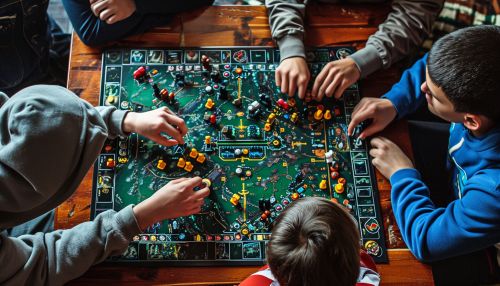Strategy game
Overview
A strategy game is a type of game where the players' decision-making skills have a high significance in determining the outcome. Often, these games emphasize long-term planning and skillful resource management over quick reflexes. Strategy games can be found across various platforms, including board games, video games, and card games.


History
The history of strategy games can be traced back to ancient civilizations. The earliest known strategy games were board games played in ancient Sumer, Egypt, and Rome. These games often involved a combination of strategy and chance, with players using their wits to overcome the random elements introduced by dice or other randomizing elements.
In the 20th century, strategy games found a new home in the world of video games. Early examples of strategy video games include titles like Chess and Civilization, which brought the strategic depth of classic board games to the digital medium.
Types of Strategy Games
Strategy games can be broadly categorized into several types, including turn-based strategy (TBS), real-time strategy (RTS), and multiplayer online battle arena (MOBA) games.
Turn-Based Strategy
In a turn-based strategy game, players take turns making their moves, allowing them to think and plan their actions with no time pressure. This type of game often involves complex strategies and tactics, as players must anticipate their opponent's moves and respond accordingly.
Real-Time Strategy
Real-time strategy games, on the other hand, do not have turns. Instead, all players play simultaneously, with the game constantly progressing in real time. This type of game requires quick thinking and fast reactions, as players must manage their resources, build their bases, and command their units in real time.
Multiplayer Online Battle Arena
Multiplayer online battle arena games, or MOBAs, are a subgenre of real-time strategy games. In a MOBA, two teams of players compete against each other, each controlling a single character with unique abilities. The objective is to destroy the opposing team's main structure, with strategic teamwork and skillful play being key to victory.
Gameplay Elements
Strategy games often involve a variety of gameplay elements, including resource management, base building, and combat.
Resource Management
In many strategy games, players must gather and manage resources. These resources, which can include things like food, wood, gold, or energy, are used to build structures, train units, and research new technologies. Effective resource management is often a key to success in strategy games.
Base Building
Base building is another common element in strategy games. Players must construct a base or stronghold, which serves as their primary source of resources and units. The base also often serves as the player's last line of defense against enemy attacks.
Combat
Combat in strategy games can take many forms, from direct confrontation between units to more indirect forms of conflict, such as economic warfare or sabotage. In many games, the player's goal is to eliminate their opponent's forces or capture their base.
Strategy Game Design
Designing a strategy game involves a careful balance of various elements. The game must be complex enough to offer meaningful choices and strategic depth, but not so complex that it becomes inaccessible to new players. Designers must also consider the game's pacing, the balance between different strategies, and the interaction between the game's mechanics and its theme.
Impact and Influence
Strategy games have had a significant impact on the wider world of games and beyond. They have influenced the design of other types of games, and have even been used as tools for education and training. For example, military organizations have used strategy games to train officers in tactical thinking, and business schools have used them to teach principles of resource management and strategic planning.
